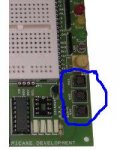rigidigital
Senior Member
Might help to click on thumbnail jpg to understand my post!
I received late yesterday all the Picaxe parts I'd ordered. A great moment as I hadn't put my hands on a chip for 3 to 4 years. I am starting allover again!
First I soldered up a breadboard adapter ,realised when it was nearly done I had used the wrong side on a couple of components so its rubbish. No worries , not needed really to put a stereo connector on a board.
Today I took out the AXE091 development board. No instruction at all. There will lots of trial and even more error
I had small trouble getting pin 5 High to light a LED on the AXE091 Dev Board.
The pin sockets circled in red are numbered 1 through 10. While 08M was running
I tried to use both pin socket 5 then 2. Neither got the LED working.
On the Right side of socket holding the 08M the pin sockets number 11 to 20.
The pin socket that went high was number 18 which is directly adjacent to the 5th
Pin of the 08MPicaxe. And that pin is called/referred 2 when programming.
So I just found the numbering of pin sockets useless when all that happens is the pin socket is ‘bound’ to the adjacent pin of the Picaxe right beside it.
I received late yesterday all the Picaxe parts I'd ordered. A great moment as I hadn't put my hands on a chip for 3 to 4 years. I am starting allover again!
First I soldered up a breadboard adapter ,realised when it was nearly done I had used the wrong side on a couple of components so its rubbish. No worries , not needed really to put a stereo connector on a board.
Today I took out the AXE091 development board. No instruction at all. There will lots of trial and even more error
I had small trouble getting pin 5 High to light a LED on the AXE091 Dev Board.
The pin sockets circled in red are numbered 1 through 10. While 08M was running
I tried to use both pin socket 5 then 2. Neither got the LED working.
On the Right side of socket holding the 08M the pin sockets number 11 to 20.
The pin socket that went high was number 18 which is directly adjacent to the 5th
Pin of the 08MPicaxe. And that pin is called/referred 2 when programming.
So I just found the numbering of pin sockets useless when all that happens is the pin socket is ‘bound’ to the adjacent pin of the Picaxe right beside it.
Attachments
-
40.4 KB Views: 51




